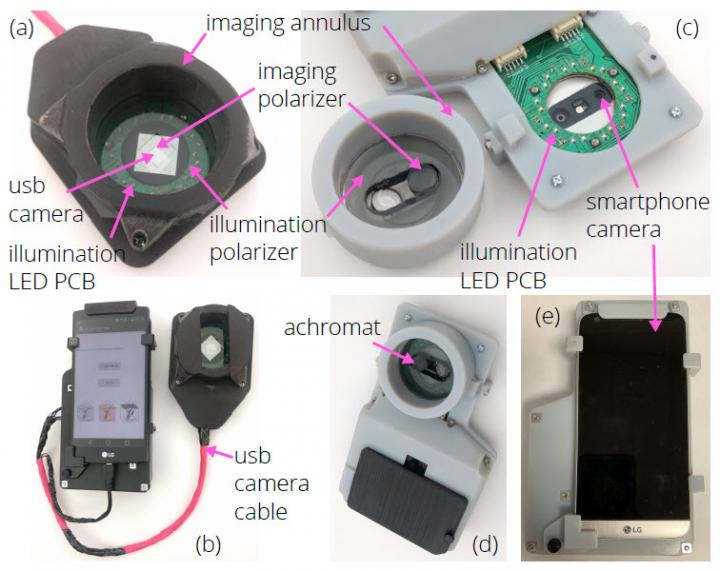Innovative research published in SPIE’s Journal of Biomedical Optics suggests low-cost, accessible diagnostic tool for skin cancer

Credit: SPIE
BELLINGHAM, Washington, USA – An article published in the Journal of Biomedical Optics (JBO), “Point-of-care, multispectral, smartphone-based dermascopes for dermal lesion screening and erythema monitoring,” shows that standard smartphone technology can be adapted to image skin lesions, providing a low-cost, accessible medical diagnostic tool for skin cancer.
Skin lesions are diagnosed by a simple system of color, size, asymmetry, and surface appearance: the way in which the lesions are lit indicates differences between normal and malignant lesions. For their study, the authors developed two dermascopes using a smartphone-based camera and a USB-based camera. Both dermascopes, integrating LED-based polarized white-light imaging (PWLI), polarized multispectral imaging (PMSI) and image-processing algorithms, successfully mapped and delineated between the dermal chromophores indicative of melanoma, and the general skin redness known as erythema.
According to JBO Editor-in-Chief, SPIE Fellow, and MacLean Professor of Engineering at Dartmouth Brian W. Pogue, leveraging a smartphone camera to image skin lesions improves both the efficiency and efficacy of skin-lesion diagnostics. “The functionality and performance for the detection of skin cancers is very important,” he said. “The cellphone camera approaches proposed and tested in this paper introduce key steps in a design that will provide simple, accurate diagnoses. While there are always ways to make medical imaging systems work, they can often be too expensive to be a viable commercial success. Similarly, devices can be made so complex that they aren’t readily adopted. Here, the already-familiar platform is both low cost and intuitive to use. The simplicity of the approach here successfully combines the need for simple diagnostic tools with high precision. This is the kind of innovation that will potentially allow for easier adoption in clinical use.”
###
The article authors are Ross D. Uthoff, Bofan Song, and Rongguang Liang of James C. Wyant College of Optical Sciences, The University of Arizona, and Melody Maarouf and Vivian Shi of the College of Medicine, Department of Medicine, Division of Dermatology, The University of Arizona.
JBO, a peer-reviewed, open-access journal, is published by SPIE in the SPIE Digital Library, which contains more than 500,000 publications from SPIE journals, proceedings, and books, with approximately 18,000 new research papers added each year.
About SPIE
SPIE is the international society for optics and photonics, an educational not-for-profit organization founded in 1955 to advance light-based science, engineering, and technology. The Society serves more than 255,000 constituents from 183 countries, offering conferences and their published proceedings, continuing education, books, journals, and the SPIE Digital Library. In 2019, SPIE provided more than $5.6 million in community support including scholarships and awards, outreach and advocacy programs, travel grants, public policy, and educational resources. http://www.
Contact:
Daneet Steffens
Public Relations Manager
[email protected]
+1 360 685 5478
@SPIEtweets
Media Contact
Daneet Steffens
[email protected]
Original Source
https:/
Related Journal Article
http://dx.




